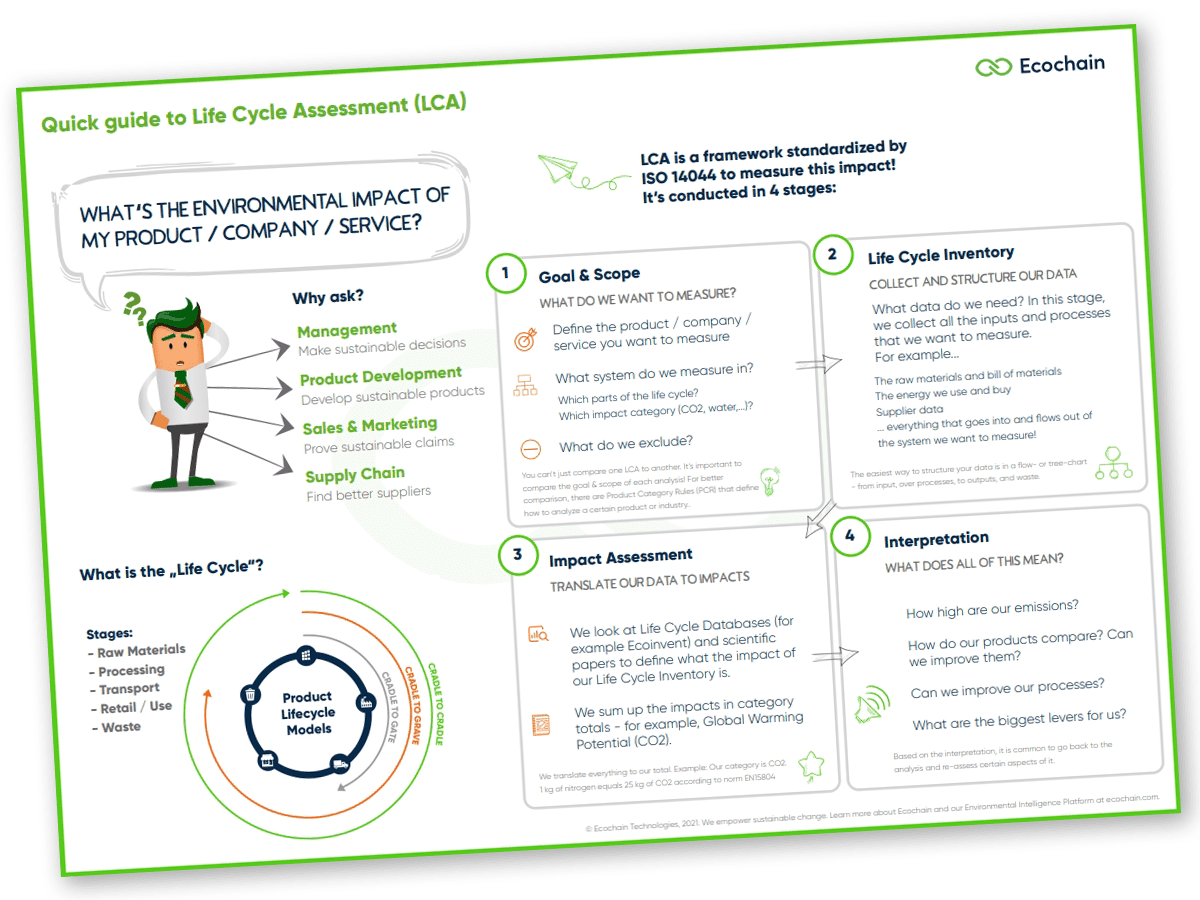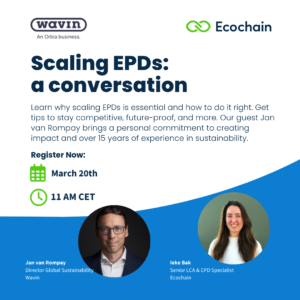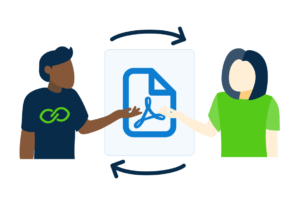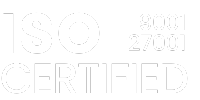A Life Cycle Assessment (LCA) is an analysis of the impact one object has on the world around it. But who benefits from it? How does it work exactly? In this guide, you get an in-depth, non-technical overview of:
生命周期评估 (LCA) 是对一个对象对其周围世界的影响的分析。但谁从中受益?它究竟是如何运作的?在本指南中,您将对以下内容进行深入的非技术概述:
- What a Life Cycle Assessment really is,
生命周期评估的真正含义是 - The different approaches to it,
不同的方法, - How it works in practice,
它在实践中如何运作, - And who can benefit from it.
谁可以从中受益。
Not wanting to read? We made a video as well! Watch it online.
不想读?我们还制作了一个视频! 在线观看 。
Read all our LCA content in our LCA Hub!
在我们的 LCA 中心阅读我们所有的 LCA 内容!
What is a Life Cycle Assessment (LCA)?
什么是生命周期评估 (LCA)?
What environmental impact does one object have on the world?
一个物体对世界有什么环境影响?
You probably asked yourself that question many times (sometimes without even knowing it). For example in the supermarket:
你可能问过自己很多次这个问题(有时甚至不知道)。例如在超市:
“How environmentally friendly were the products I just bought? Should I have bought the tomatoes from The Netherlands or from Spain?“
“我刚买的产品有多环保? 我应该从荷兰还是西班牙买西红柿?
This, in a nutshell, is the question that a Life Cycle Assessment tries to answer. An LCA measures the environmental impact of a product through every phase of its life – from production to waste (or recycling, etc.).
简而言之,这就是生命周期评估试图回答的问题。生命周期评价衡量产品在其生命周期的每个阶段(从生产到废弃物(或回收等))对环境的影响。
But LCA isn’t simple – there are countless factors involved:
但 LCA 并不简单——涉及无数因素:
- Which raw materials were involved in the production process, and where do they come from? What about soil, seeds, and fertilizer?
生产过程中涉及哪些原材料,它们来自哪里?土壤、种子和肥料呢? - How do my goods get produced? What about heating, water, and ventilation?
我的商品是如何生产的?供暖、水和通风呢? - How did the goods get transported? Via truck, rail, or airplane?
货物是如何运输的?通过卡车、铁路还是飞机?
A clear framework for measuring environmental impact
衡量环境影响的明确框架
With all these factors – it gets confusing quickly. This is why the Life Cycle Assessment provides a framework for measuring the environmental impact of, for example, a product.
考虑到所有这些因素,它很快就会变得混乱。这就是为什么生命周期评估提供了一个框架来衡量产品等对环境的影响 。
The goal of an LCA is to not only create data but also to facilitate decisions. That’s why it is always designed with a specific goal in mind. For example, to make a product more sustainable.
LCA 的目标不仅是创建数据,而且是促进决策。 这就是为什么它在设计时始终牢记特定目标。例如,使产品更具可持续性 。
In this guide, we go through the concept of a Life Cycle Assessment step-by-step. The structure:
在本指南中,我们将逐步介绍生命周期评估的概念。结构:
- Who needs an LCA? And why? Why we should conduct an LCA in the first place. Who is it relevant for? Who can benefit from it?
谁需要 LCA?为什么? 为什么我们应该首先进行 LCA。它与谁相关?谁可以从中受益? - The product Lifecycle. What are the different phases in a product’s lifecycle?
产品生命周期。 产品生命周期有哪些不同的阶段? - The 4 Phases of a Life Cycle Assessment.
生命周期评估的 4 个阶段。 - LCA Standards and the legal situation – a quick overview
LCA 标准和法律状况 – 快速概述 - LCA: Criticism LCA:批评
- LCA Tools you can use
您可以使用的 LCA 工具
1. Who needs an LCA? And why?
1. 谁需要 LCA?为什么?
Before we dive into how a Life Cycle Assessment works, let’s break down who needs it in the first place.
在我们深入研究生命周期评估的工作原理之前,让我们先分解一下谁首先需要它。
Sustainability – Relevant For Everybody?
可持续性 – 与每个人都相关?
If you think about who might be interested in knowing more about the impact of your company, you could probably name everybody.
如果您想想谁可能有兴趣更多地了解您公司的影响,您可能会说出每个人的名字。
For example, HR managers might argue that potential candidates find it interesting to know more about the environmental footprint of their future employer.
例如,人力资源经理可能会争辩说,潜在候选人认为更多地了解他们未来雇主的环境足迹很有趣。
But LCA is a very specific analysis. It provides the groundwork for any sustainability or CSR strategy within a company. That’s because you can only make decisions on things you’ve actually measured before.
但 LCA 是一种非常具体的分析。 它为公司内的任何可持续发展或 CSR 战略提供了基础。那是因为你只能根据你以前实际衡量过的事情做出决定。
According to our data, the following 4 departments in your company can take action based on an LCA right away.
根据我们的数据,贵公司的以下 4 个部门可以立即根据 LCA 采取行动。
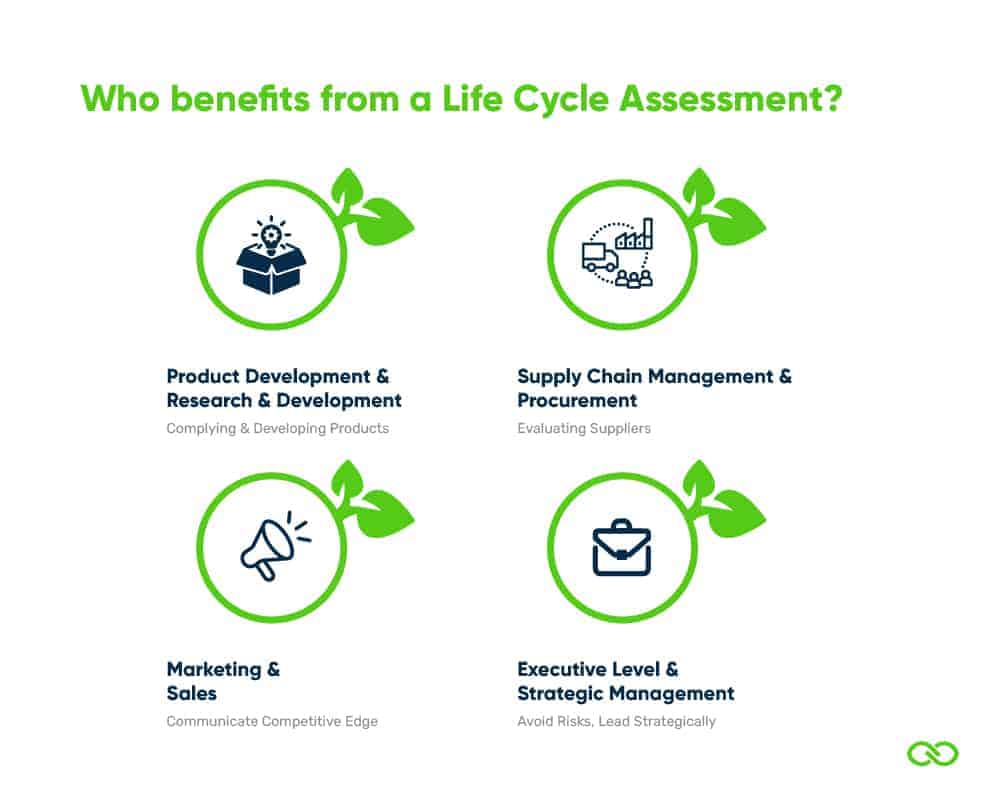
Product Management / Research & Development (R&D)
产品管理 / 研发 (R&D)
There are two reasons why a Life Cycle Assessment can be interesting for product management.
生命周期评估对产品管理感兴趣有两个原因。
Reason 1: Comply With Regulations
原因 1:遵守法规
Often, companies need to simply comply with regulations to continue doing business.
通常,公司只需遵守法规即可继续开展业务。
In some countries, there are standardized tenders for public projects. These tenders require companies to disclose the environmental data of their products – and you would have to conduct a Life Cycle Assessment for that.
在一些国家/地区,公共项目有标准化的招标。这些招标要求公司披露其产品的环境数据,您必须为此进行生命周期评估。
A company that provides asphalt for a public road-building project might, for example, needs to provide the environmental footprint of that product to take part in that tender. To comply with these regulations, or optimizing existing products so they comply in the future, can be important for the product department.
例如,为公共道路建设项目提供沥青的公司可能需要提供该产品的环境足迹才能参加该招标。遵守这些法规或优化现有产品以使其在未来符合要求,对产品部门来说可能很重要。
Reason 2: New Product Development
理由 2:新产品开发
New products should be as low in emissions as possible. This can be for many reasons – corporate policy, regulations, customer demand – but oftentimes, it simply means being more efficient with company resources.
新产品的排放量应尽可能低。这可能有很多原因 - 公司政策、法规、客户需求 - 但通常,这只是意味着更有效地利用公司资源。
One use case for an LCA might be that R&D compares two different materials and how these different materials influence the environmental impact of the end product.
LCA 的一个用例可能是 R&D 比较两种不同的材料,以及这些不同的材料如何影响最终产品的环境影响。
Supply Chain Management / Procurement
供应链管理 / 采购
In many industries, the supply chain accounts for more than 80 % of the environmental impact.
在许多行业中, 供应链占环境影响的 80% 以上 。
That means that sourcing from different suppliers can have a massive impact on your product footprint.
这意味着从不同的供应商处采购会对您的产品足迹产生巨大影响。
For Supply Chain Managers, choosing the right supplier is often a hard decision, where far more factors than just price play a role. A Life Cycle Assessment can give anyone working in Supply Chain Management or Procurement actionable insights into which company they should source from.
对于供应链经理来说,选择合适的供应商通常是一个艰难的决定,其中起作用的因素远不止价格。生命周期评估可以为从事供应链管理或采购工作的任何人提供可作的见解,让他们了解他们应该从哪家公司采购。
Marketing & Sales 营销与销售
Today, more than 81 % of consumers feel that companies should help improve the environment.
今天,超过 81% 的消费者认为公司应该帮助改善环境 。
For marketing and sales, this means understanding how sustainable your products are – and how to communicate this to your customers.
对于营销和销售来说,这意味着了解您的商品的可持续性,以及如何将其传达给您的客户。
A Life Cycle Assessment is the most vital step on that journey. Based on the generated insights, you can see where you already have an edge over your competitors – and where your company can use opportunities to become more sustainable.
生命周期评估是该旅程中最重要的一步。根据生成的见解 ,您可以看到您在哪些方面已经比竞争对手更具优势,以及您的公司可以在哪些方面利用机会变得更加可持续。
Executive Level & Strategic Management
执行级别和战略管理
Chief Sustainability Officers are still a relatively new position. But more and more companies u understand sustainability isn’t a topic to be solved with simple greenwashing.
首席可持续发展官仍然是一个相对较新的职位。但越来越多的公司明白,可持续发展不是一个可以通过简单的漂绿来解决的话题。
To make strategic decisions on how a company can have a more positive impact on the environment, buy-in from the highest level is important. This is why every LCA should transport actionable insights to the top management level.
为了就公司如何对环境产生更积极的影响做出战略决策 ,获得最高层的支持非常重要。这就是为什么每个 LCA 都应该将可行的见解传达给最高管理层。
An LCA looks at products from a broader point of view and analyses more than just carbon impact. That’s why it usually creates insights that another analysis might lose out on – an enormous chance for the entire company.
生命周期评估从更广泛的角度看待产品,分析的不仅仅是碳影响。这就是为什么它通常会产生其他分析可能会失去的见解——这对整个公司来说都是一个巨大的机会。
Recap: Who is an LCA interesting for?
回顾:LCA 对谁感兴趣?
Product Management / Research & Development:
产品管理 / 研发:
1. Comply with regulations, 2. Develop new sustainable products
1. 遵守法规,2.开发新的可持续产品
Supply Chain Management & Procurement
供应链管理与采购
Find better suppliers 寻找更好的供应商
Marketing & Sales 营销与销售
Act on customer demand for sustainability
根据客户对可持续发展的需求采取行动
Executive Level & Strategic Management
执行级别和战略管理
Incorporate sustainability in the entire business
将可持续性融入整个企业
Sidenote: Sustainability often sounds like an abstract construct. In reality, being more sustainable can simply mean using less energy, recycling materials, or streamlining processes. All actions can save large amounts of money, immediately increase the bottom line, and make a company less dependent.
旁注: 可持续性通常听起来像是一个抽象的概念。实际上, 更可持续可能仅仅意味着使用更少的能源、回收材料或简化流程。所有行动都可以节省大量资金,立即提高底线,并减少公司的依赖性。
Before we dive into the process of an LCA, let us define what the product life cycle actually is.
在我们深入研究 LCA 的流程之前,让我们定义一下产品生命周期的实际含义。
2. The Product Life Cycle in LCA
2. LCA 中的产品生命周期
If we want to assess the life cycle of a product, we have to first define what that lifecycle actually consists of.
如果我们想评估产品的生命周期,我们必须首先定义该生命周期的实际组成部分。
5 Steps of a product life cycle: From Cradle To Grave
产品生命周期的 5 个步骤:从摇篮到坟墓
We will talk about different concepts of the product life cycle in just a moment, but generally, the product life cycle consists of five phases:
我们稍后将讨论产品生命周期的不同概念,但一般来说,产品生命周期包括五个阶段:
The 5 Steps of a Product Life Cycle (Cradle to Grave)
产品生命周期的 5 个步骤(从摇篮到坟墓)
- Raw Material Extraction 原材料提取
- Manufacturing & Processing
制造与加工 - Transportation 运输
- Usage & Retail 使用与零售
- Waste Disposal 废物处理
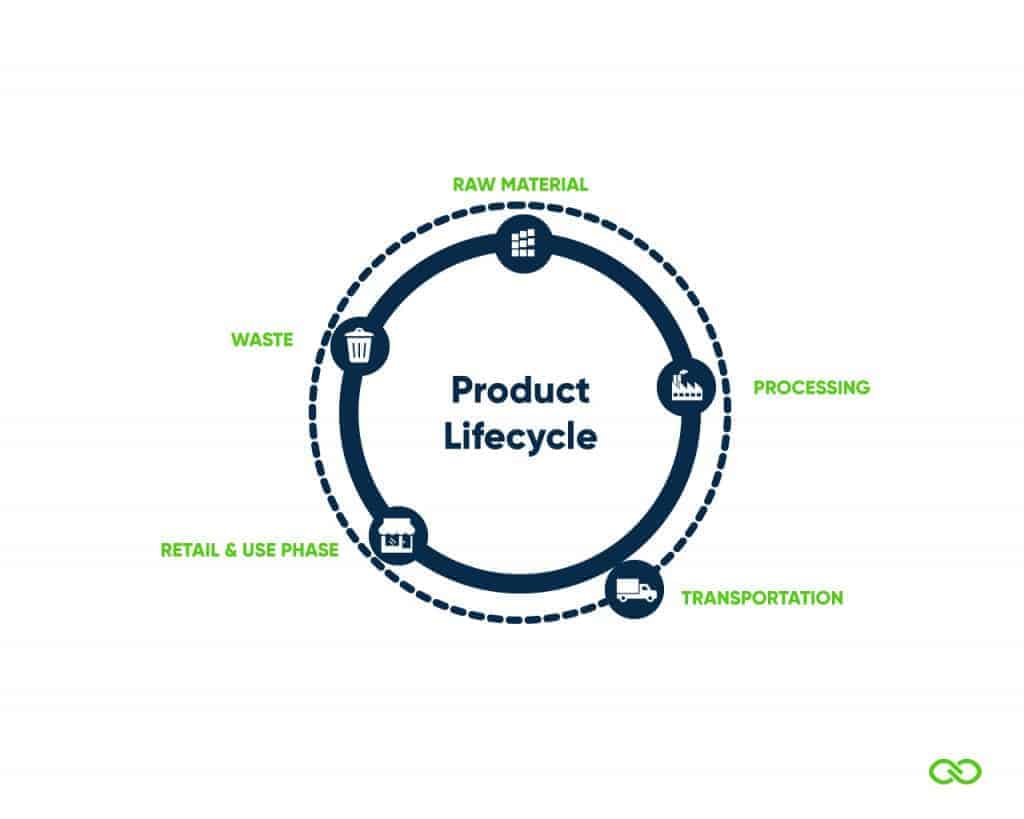
Different Life cycle models
不同的生命周期模型
Based on the stages you’re interested in or have data available on, you can choose to leave in or take out phases. There are usually 4 product life cycle models you can choose for your LCA.
根据您感兴趣的阶段或有可用的数据,您可以选择保留或取出阶段。通常,您可以为 LCA 选择 4 种产品生命周期模型。
Cradle-to-grave 从摇篮到坟墓
When you analyze a product’s impact along the 5 product lifecycle steps – this is called cradle-to-grave. Cradle being the inception of the product with the sourcing of the raw materials, grave being the disposal of the product. Transportation is mentioned as step 3, but can, in reality, occur in between all steps.
当您分析产品对产品生命周期 5 个步骤的影响时,这称为 “从摇篮到坟墓 ”。 摇篮是产品与原材料采购的开始, 坟墓是产品的处置。运输被称为第 3 步,但实际上可能发生在所有步骤之间。
Cradle-to-gate 摇篮到大门
Cradle-to-gate only assesses a product until it leaves the factory gates before it is transported to the consumer.
“从摇篮到大门” 仅对产品进行评估,直到产品离开工厂大门,然后再运输给消费者。
This means cutting out the use and disposal phase. Cradle-to-gate analysis can significantly reduce the complexity of an LCA and thus create insights faster, especially about internal processes. Cradle-to-gate assessments are often used for environmental product declarations (EPD).
这意味着省去了使用和处置阶段。“从摇篮到大门” 分析可以显著降低 LCA 的复杂性,从而更快地获得见解,尤其是关于内部流程的见解。“从摇篮到大门”评估通常用于环境产品声明 (EPD)。
Environmental Product Declarations (EPD)
环保产品声明 (EPD)
Environmental Product Declarations are standardized certifications of a life cycle assessment, used mostly to verify impact data from business to business.
环境产品声明是生命周期评估的标准化认证,主要用于验证企业之间的影响数据 。
Cradle-to-cradle Cradle-to-cradle (摇篮到摇篮)
Cradle-to-cradle is a concept often referred to within the Circular Economy. It is a variation of cradle-to-grave, exchanging the waste stage with a recycling process that makes it reusable for another product, essentially “closing the loop”. This is why it is also referred to as closed-loop recycling.
Cradle-to-cradle 是循环经济中经常提到的一个概念。它是 cradle-to-grave 的一种变体,将废物阶段换成回收过程,使其可重复用于另一种产品,本质上是“闭环”。这就是为什么它也被称为闭环回收 。
Gate-to-gate 门到门
Gate-to-gate is sometimes used in product life cycles with many value-adding processes in the middle.
门到门有时用于产品生命周期中,中间有许多增值过程。
To reduce complexity in the assessment, only one value-added process in the production chain is assessed. These assessments can later be linked together to complete a larger level Life Cycle Assessment.
为了降低评估的复杂性,只评估生产链中的一个增值过程。这些评估稍后可以链接在一起,以完成更高级别的生命周期评估。

Life Cycle Models in LCA – Ecochain
生命周期评估中的生命周期模型 – Ecochain
There are three other LCA concepts that are used for special requirements.
还有三个其他 LCA 概念用于特殊要求。
Well-To-Wheel Well-To-Wheel (从油井到车轮)
Well-to-wheel is used for the Life Cycle Assessment of transport fuels and vehicles. Because there are a lot of steps in between – the “Well-to-tank” and “Tank-to-wheels”, this approach is more precise in calculating and assigning greenhouse gas emissions and energy usage for the different stages.
油井到车轮用于运输燃料和车辆的生命周期评估。因为中间有很多步骤——“油井到油箱”和“油箱到车轮”,所以这种方法在计算和分配不同阶段的温室气体排放和能源使用方面更加精确。
Economic Input-Output Life Cycle Assessment
经济投入产出生命周期评估
The EIOLCA aggregates industry data with the goal to create impact data for specific sectors within the economy. These averages are sometimes used when no exact data is available. They don’t provide an exact picture of the impact but help to fill blanks. However, an EIOLCA is not precise enough to make decisions on a product level.
EIOLCA 汇总行业数据,旨在为经济中的特定部门创建影响数据 。在没有确切数据可用时,有时会使用这些平均值。它们没有提供影响的确切情况,但有助于填补空白。然而,EIOLCA 不够精确,无法在产品层面做出决策。
Environmental Impact Assessment
环境影响评估
Environmental Impact Assessment is an analysis that is often conducted in the public sector, to look at the potential impact of a new construction project.
环境影响评估是一种通常在公共部门进行的分析,旨在了解新建筑项目的潜在影响。
3. The 4 Phases of a Life Cycle Assessment
3. 生命周期评估的 4 个阶段
Now that we understand the differences between LCA models, we dive deeper into the actual phases of an LCA. The phases of a Life Cycle Assessment are defined in the ISO standards 14040 and 14044.
现在我们了解了 LCA 模型之间的差异,我们更深入地研究了 LCA 的实际阶段。生命周期评估的阶段在 ISO 标准 14040 和 14044 中定义。
A Life Cycle Assessment Consists Of 4 Phases:
生命周期评估包括 4 个阶段:
- Definition of Goal and Scope
目标和范围的定义 - Inventory Analysis
库存 分析 - Impact Assessment
冲击 评估 - Interpretation 解释
But as you can see in the graphic below, the different steps depend on each other.
但如下图所示,不同的步骤是相互依赖的。
Moreover, the interpretation of the LCA doesn’t always have to depend on the actual assessment being completely finished.
此外,LCA 的解释并不总是取决于实际评估是否完全完成。
Especially when a Life Cycle Assessment becomes more complex, continuously interpreting the results helps optimize the analysis as it goes further down the process.
特别是当生命周期评估变得更加复杂时,持续解释结果有助于优化分析,因为它会进一步深入。

Phase 1: Definition of Goal and Scope
第 1 阶段:定义目标和范围
In the first phase of our Life Cycle Assessment, we define what exactly we want to analyze – and how deep we want to go with our analysis.
在生命周期评估的第一阶段,我们定义我们到底想要分析什么,以及我们想要进行多深入的分析。
Defining our goal and scope serves three very important functions:
定义我们的目标和范围有三个非常重要的功能:
1. What will we be assessing?
1. 我们将评估什么?
Will it be a product? If so, how much of the product will we be assessing (functional unit)?
它会是产品吗?如果是这样,我们将评估产品的多少(功能单元)?
2. What system will we be assessing in?
2. 我们将在什么系统中进行评估?
This defines our product life cycle, as well as the implications we will be analyzing. Also, we have to decide which Impact Categories we want to focus our assessment on.
这定义了我们的产品生命周期,以及我们将要分析的影响。此外,我们还必须决定要评估的重点是什么影响类别 。
We might, for example, want to generate an Environmental Product Declaration for one of our products. If that is the goal, we have to build our assessment around the methods required by the political bodies, for example, the ministry of construction.
例如,我们可能希望为我们的某个产品生成环境 产品声明 。如果这是目标,我们必须围绕政治机构(例如建设部)要求的方法构建我们的评估。
3. What Will We Not Be Assessing?
3. 我们不会评估什么?
The value chain can go very deep.
价值链可以非常深入。
However, a certain depth might not be interesting for our analysis. We might, for example, decide, that we won’t analyze the details of the pre-forms of our raw materials in-depth. Also, the social implications of the unit we are assessing might not be completely relevant.
但是,对于我们的分析来说,一定的深度可能并不有趣。例如,我们可能会决定不深入分析原材料预制件的细节。此外,我们正在评估的单元的社会影响可能并不完全相关。
This is an extremely important step. Because an analysis can – in theory – never be fully finished. If we analyze a certain raw material, will we also examine the implications it has on the family of the worker who harvested it?
这是极其重要的一步。因为从理论上讲,分析永远不会完全完成。如果我们分析某种原材料,我们是否也会检查它对收获它的工人家庭的影响?
Recap: 1. Step of an LCA – Goal & Scope
回顾:1. LCA 的步骤 - 目标和范围
Defining the goal & scope of an LCA means defining what we want to analyze, how we want to analyze it, and how far we want to go with our analysis.
定义 LCA 的目标和范围意味着定义我们想要分析的内容,我们如何分析,以及我们希望通过分析走多远。

Life Cycle Assessment Example: Goal & Scope
生命周期评估示例:目标和范围
To show how an LCA can look in practice, we use the example of a simple T-Shirt. A T-Shirt by itself is a relatively simple product. However, you still need to take a number of things into account to create a proper Life Cycle Assessment. We modeled our T-Shirt LCA in Mobius, our own easy Product Footprint tool.
为了展示 LCA 在实践中的样子,我们以简单的 T 恤为例。T 恤本身就是一个相对简单的产品。但是,您仍然需要考虑许多因素来创建适当的生命周期评估。我们在 Mobius 中建模了我们的 T 恤 LCA,这是我们自己的简单产品足迹工具 。
Summary of the goal and scope of the analysis of a T-Shirt:
T 恤分析的目标和范围总结:
- The goal is to make the T-Shirt more sustainable by reducing its emissions during the lifecycle. Another goal is to manufacture it more efficiently by streamlining processes.
目标是通过减少生命周期内的排放,使 T 恤更具可持续性。另一个目标是通过简化流程来更高效地制造它。 - We will look at the T-Shirt as a whole, analyzing the environmental impact from cradle to grave. We will look at the CO₂ emissions caused by one T-Shirt.
我们将把 T 恤作为一个整体来看待,分析从摇篮到坟墓的环境影响。我们将研究一件 T 恤造成的二氧化碳排放量。
In this video, we model a simple product LCA of a T-Shirt in Ecochain Mobius, our own easy product footprint tool.
在本视频中,我们在 Ecochain Mobius(我们自己的简单产品足迹工具)中对 T 恤的简单产品生命周期评估进行建模。
Phase 2: Life Cycle Inventory (LCI)
第 2 阶段:生命周期清单 (LCI)

The Life Cycle Inventory Analysis (LCI) looks at the environmental inputs and outputs of a product or service. It is essentially the data collection phase of our LCA.
生命周期清单分析 (LCI) 着眼于产品或服务的环境输入和输出。它本质上是我们 LCA 的数据收集阶段。
Look at it as buckets:
将其视为存储桶:
In phase 1, we defined the buckets we want to put our data in, in phase 2 we fill the buckets.
在第 1 阶段,我们定义了要将数据放入的存储桶,在第 2 阶段,我们填充了存储桶。
The goal is to quantify the environmental inputs and outputs – this means we measure everything that flows in and out of the system we defined in phase 1.
目标是量化环境输入和输出 – 这意味着我们测量流入和流出我们在第 1 阶段定义的系统的所有物质。
What could these inputs and outputs be?
这些输入和输出可能是什么?
– Raw materials or resources
– 原材料或资源
– Different types of energy
– 不同类型的能源
– Water –水
– Emissions to air, land, or water by substance
– 物质向空气、土地或水中排放
This analysis can be extremely complex. Because production processes and supply chains can be complex constructs.
这种分析可能非常复杂。因为生产流程和供应链可能是复杂的结构。
That’s why the Life Cycle Inventory phase of the Life Cycle Assessment usually takes the most work and time in your LCA.
这就是为什么生命周期评估的生命周期盘查阶段通常在 LCA 中花费最多的工作和时间。
How is the data for the Life Cycle Inventory collected?
如何收集生命周期清单的数据?
Life Cycle Assessments today are conducted by professionals who are extensively trained in the norms and standards that define how an LCA should look like. We look deeper into these standards later in this guide. However, with software solutions like our product footprint tools Mobius and Helix, everybody can perform an LCA.
今天的生命周期评估是由专业人员进行的,他们在定义 LCA 应该是什么样子的规范和标准方面接受过广泛的培训。我们将在本指南的后面更深入地研究这些标准。但是,借助我们的产品足迹工具 Mobius 和 Helix 等软件解决方案,每个人都可以执行 LCA。
A lot of the data for the LCA is already available – for example in your electricity or water bills. But of course, that’s not all the data we need.
LCA 的很多数据已经可用——例如在您的电费或水费账单中。但当然,这并不是我们需要的全部数据。
Therefore, at Ecochain we collect data through data collection sheets at this stage. These sheets gather quantitative data on a company level, process- and product level. If we need qualitative data, we use questionnaires. The data sheets get filled out by the stakeholders in the company who have access to the data.
因此,在 Ecochain,我们在这个阶段通过数据收集表收集数据。这些表收集公司层面、流程和产品层面的定量数据。如果我们需要定性数据,我们会使用问卷。数据表由公司中有权访问数据的利益相关者填写。
Sometimes, industry averages have to be used. This is called secondary data. You can read more about the different kinds of data in our blog (primary vs secondary data).
有时,必须使用行业平均值。这称为二级数据。您可以在我们的博客中阅读有关不同类型数据的更多信息(一级数据与二级数据)。
One method for that would be the Economic input-output life cycle assessment we described earlier, which can give us data to fill in some blanks. Other times, the averages could be aggregated data gathered by branch organizations, financial institutes, NGOs, or market research organizations.
一种方法是我们前面描述的经济投入产出生命周期评估,它可以为我们提供数据来填补一些空白。其他时候,平均值可能是分支机构、金融机构、非政府组织或市场研究组织收集的汇总数据。
Modeling the LCI: Inventory Flow Models
生命周期清单建模:库存流模型
Collecting the input and output data within a list or table would quickly lead to confusion. Moreover, it would also lead to important contexts going missing.
在列表或表中收集输入和输出数据会很快导致混淆。此外,它还会导致重要的上下文丢失。
That is why the Life Cycle Inventory is typically illustrated with a flow model (image below).
这就是为什么生命周期清单通常用流动模型来说明的原因(下图)。
The flow model clearly shows the system and unit we are analyzing, and the inputs & outputs. The data within the model needs to be collected for all activities within the scope of our Life Cycle Assessment.
流程模型清楚地显示了我们正在分析的系统和单元,以及输入和输出。模型中的数据需要为我们的生命周期评估范围内的所有活动收集。
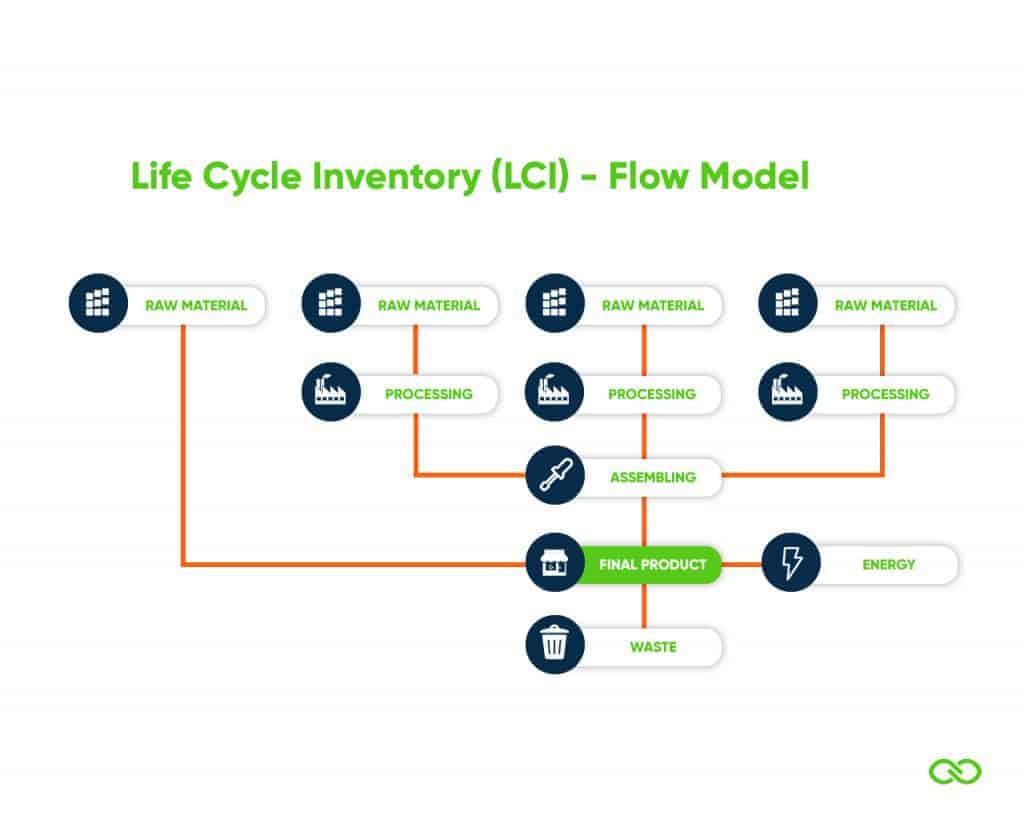
Life Cycle Assessment Example: Flow Model
生命周期评估示例:流动模型
A T-Shirt consists of fabric that is sewn together for the end product. The fabric itself also goes through different treatment processes. This is how the above flow model looks like in Mobius (you can access the full model for free by signing up for the 14-day free Mobius trial, our LCA software). Click to expand the picture!
T 恤由缝合在一起作为最终产品的织物组成。织物本身也要经过不同的处理过程。这就是上述流动模型在 Mobius 中的样子(您可以通过注册我们的 LCA 软件 14 天免费试用 Mobius 来免费访问完整模型)。点击放大图片!

And when we look at it in a structural tree diagram, this is what the life cycle inventory of a T-Shirt looks like.
当我们在结构树图中查看它时,这就是 T 恤的生命周期清单的样子。
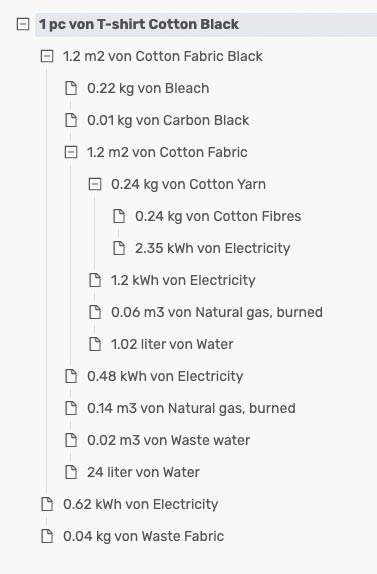
Recap: Phase 2 of an LCA: Life Cycle Inventory
回顾:生命周期评估的第 2 阶段:生命周期清单
The LCI is the data collection phase of a Life Cycle Assessment. We collect the data and model it into input-output flows.
生命周期证明是生命周期评估的数据收集阶段。我们收集数据并将其建模为输入-输出流。
Now that we have collected the data, it’s time to assign it in the next phase – the Life Cycle Impact Assessment (LCIA).
现在我们已经收集了数据,是时候在下一阶段 – 生命周期影响评估 (LCIA) 中分配数据了。
Phase 3: Life Cycle Impact Assessment
第 3 阶段:生命周期影响评估

Until now, we defined what we want to measure and collect in phase 1. Then we collected and structured the data in phase 2.
到目前为止,我们定义了要在第 1 阶段衡量和收集的内容。然后,我们在第 2 阶段收集并构建了数据。
In phase 3, we evaluate how significant the impacts are. This is based on our Life Cycle Inventory flows from phase 2.
在第 3 阶段,我们评估影响的严重程度。这是基于我们第 2 阶段的生命周期清单流程。
There are 3 key tasks in this step.
此步骤有 3 个关键任务。
Task 1: Selection of indicators and models
任务 1:指标和模型的选择
In phase 1 of our LCA, we defined our Impact Categories based on our goals. Impact Categories are what you want to measure your impact in. For example, you might want to measure the impact of your products on climate change in CO₂-equivalent.
在 LCA 的第 1 阶段,我们根据目标定义了影响类别 。 影响类别是您想要衡量影响的类别。例如,您可能希望以二氧化碳当量来衡量您的产品对气候变化的影响。
Now, we define these impact categories more precisely.
现在,我们更精确地定义这些影响类别 。
There are many impact categories to choose from (15+). Depending on the goal and scope of your analysis, different categories might apply. The following are the most commonly used:
有许多影响类别可供选择 (15+)。根据分析的目标和范围,可能适用不同的类别。以下是最常用的类别:
Common Impact Categories 常见影响类别
- Human toxicity 人体毒性
- Global Warming Potential (carbon footprint)
全球变暖潜能值(碳足迹) - Ecotoxicity 生态毒性
- Acidification 酸化
- Eutrophication 富营养化
Why are some impact categories measured in “equivalents”?
为什么有些影响类别以“等价物”来衡量?
Some impact categories are measured in equivalents, often seen as a lowercase e or eq, for example, CO₂-e for CO₂-equivalent.
一些影响类别以当量衡量,通常被视为小写的 e 或 eq,例如,CO₂-e 表示 CO₂ 当量 。
This is because several emissions contribute to the same impact category. For example, climate change or global warming potential (GWP) is measured in CO₂-equivalents. This doesn’t mean only CO₂ contributes to global warming, because, for example, also methane and nitrous oxide play a role there.
这是因为多种排放会产生相同的影响类别。 例如,气候变化或全球变暖潜能值 (GWP) 以二氧化碳当量来衡量。这并不意味着只有二氧化碳会导致全球变暖,因为甲烷和一氧化二氮也在那里发挥作用。
But to consolidate all gases into one indicator, all other gases are transposed into CO₂ equivalents.
但是,为了将所有气体整合到一个指示剂中,所有其他气体都被转移到 CO₂ 当量中。
Example 例
1kg CO₂ = 1kg CO₂-equivalent
1 千克二氧化碳 = 1 千克二氧化碳当量
1kg Methane (CH4) = 25kg CO₂-equivalent
1 千克甲烷 (CH4) = 25 千克二氧化碳当量
1kg Nitrous oxide (N2O) = 298kg CO₂-equivalent
1 千克一氧化二氮 (N2O) = 298 千克二氧化碳当量
By assigning an equivalent, we can compare all these inputs to each other. Much like if you want to compare different currencies to each other.
通过分配等价物,我们可以将所有这些输入相互比较。就像你想将不同的货币相互比较一样。
However, the calculation of the equivalents doesn’t happen until step 3 in our impact assessment. First, we have to choose from the impact categories that are relevant to our overall assessment.
但是,直到我们影响评估的第 3 步才开始计算等价物。首先,我们必须从与整体评估相关的影响类别中进行选择。
Task 2: Classification 任务 2:分类
In this step of our Life Cycle Impact Assessment, we are sorting our Life Cycle Inventory and assigning it to our defined impact categories.
在生命周期影响评估的这一步中,我们将对生命周期清单进行排序,并将其分配到我们定义的影响类别中 。
Task 3: Impact Measurement
任务 3:影响测量
In the last step of our impact assessment, we finally calculate all our equivalents. We sum them up in overall impact category totals.
在影响评估的最后一步,我们最终计算所有等效项。我们将它们总结为总体影响类别总数。
Category Totals can look like this:
类别总计 (Category Totals) 可能如下所示:
- Environmental Cost Indicator (ECI) in EUR (or other currencies)
以欧元(或其他货币)计价的环境成本指标 (ECI) - Global Warming Potential (CO₂-equivalent in kg)
全球变暖潜能值(二氧化碳当量,单位为千克) - Depletion potential of the stratospheric ozone layer (CFC-11-equivalent in kg)
平流层臭氧层的消耗潜能值(CFC-11 当量,单位为 kg) - Acidification potential of land and water (SO2-equivalent in kg)
陆地和水的酸化潜能值(以 kg 为单位的 SO2 当量) - Eutrophication potential (PO4-3-equivalent in kg)
富营养化潜能值(PO4-3 等效物,单位为 kg) - Formation potential of tropospheric ozone photochemical oxidants (ethene-equivalent in kg)
对流层臭氧光化学氧化剂的形成电位(以 kg 为单位的乙烯当量) - Abiotic depletion potential for non-fossil resources (Sb-equivalent in kg)
非化石资源的非生物消耗潜能值(Sb 当量,单位为 kg) - Human toxicity potential (1,4-DB-equivalent in kg)
人类毒性潜力(1,4-DB 等效物,单位为 kg) - Freshwater aquatic ecotoxicity potential (1,4-DB-equivalent in kg)
淡水水生生态毒性潜力(1,4-DB 等效物,以千克为单位) - Marine aquatic ecotoxicity potential (1,4-DB-equivalent in kg)
海洋水生生态毒性潜力(1,4-DB 当量,以千克计) - Terrestrial ecotoxicity potential (1,4-DB-equivalent in kg)
陆地生态毒性潜力(1,4-DB 等效物,单位为 kg)
Life Cycle Assessment Example: LCI
生命周期评估示例:生命周期清单
Now that we know what we want to measure, what does the impact of the T-Shirt look like? Let’s look into our example in Ecochain Mobius again. In this example, we decided to measure the footprint of our T-Shirt in CO₂-equivalent, which is also called “Global Warming Potential”, short GWP. You can see that a lot of the impact of the T-Shirt comes from electricity.
既然我们知道了我们想要测量什么,那么 T 恤的影响是什么样的?让我们再次看一下 Ecochain Mobius 的例子。在这个例子中,我们决定以二氧化碳当量来衡量 T 恤的足迹,也称为“全球变暖潜能值”,简称 GWP。您可以看到,T 恤的很多影响都来自电力。
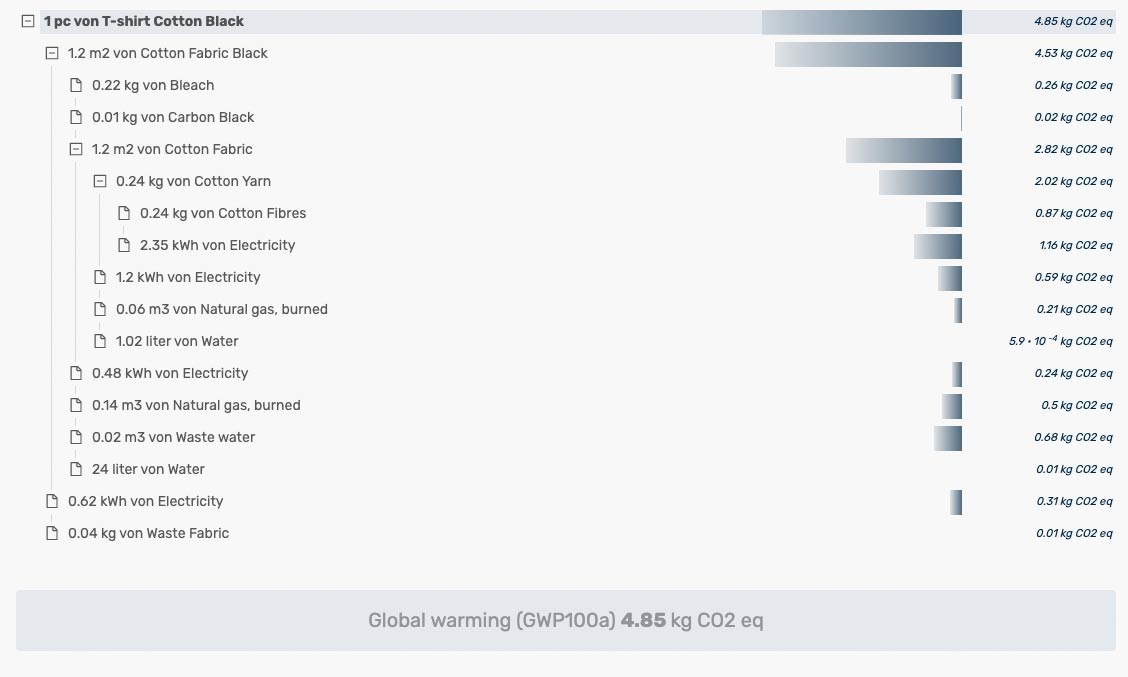
But how much actually comes from electricity? Mobius allows us to choose another view of our results. And in the flat view, our results are nicely summed up.
但实际上有多少来自电力呢?Mobius 允许我们选择结果的另一种视图。在平面视图中,我们的结果得到了很好的总结。
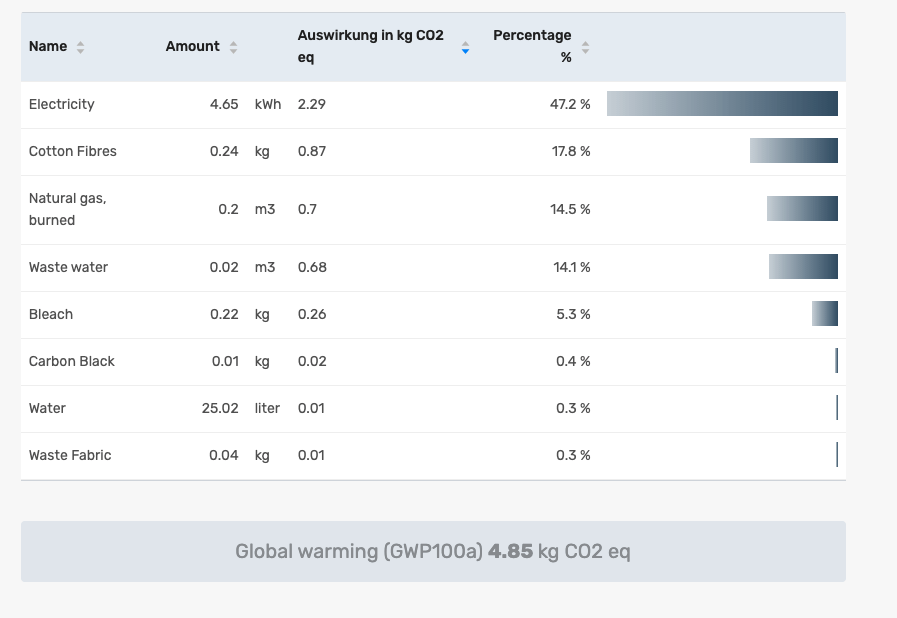
Now we see that almost 50% of the carbon footprint of our T-Shirt actually comes from the electricity we use to manufacture them. Only about 18% come from cotton fibers.
现在我们看到,我们 T 恤的碳足迹中近 50% 实际上来自我们用于制造它们的电力。只有大约 18% 来自棉纤维。
Now, let’s interpret our results.
现在,让我们解释一下我们的结果。
Phase 4: Interpretation of our Life Cycle Assessment
第 4 阶段:解读我们的生命周期评估

As previously mentioned, we can always interpret our results during the assessment.
如前所述,我们始终可以在评估过程中解释我们的结果。
This means that the interpretation doesn’t necessarily have to happen at the very end.
这意味着解释不一定必须在最后进行。
But with all the data in place, we make the most reliable conclusions and recommendations.
但是,有了所有数据,我们就会得出最可靠的结论和建议。
This has to be done cautiously – just because three is lower than four, doesn’t mean that it is automatically the better alternative. Our results have to be put in context to analyze the overall picture.
这必须谨慎进行——仅仅因为 3 比 4 低,并不意味着它自动成为更好的选择。我们的结果必须放在上下文中,以分析整体情况。
What we want to interpret is also defined in the ISO norms defining the Life Cycle Assessment.
我们想要解释的内容也在定义生命周期评估的 ISO 规范中进行了定义。
According to ISO 14044:2006, this is what the interpretation of a Life Cycle Assessment should include:
根据 ISO 14044:2006, 生命周期评估的解释应包括以下内容:
- Identifying significant issues based on our LCI and LCIA phase
根据我们的 LCI 和 LCIA 阶段确定重大问题 - Evaluating the study itself, how complete it is, if it’s done sensitively and consistently
评估研究本身,它的完成程度如何,是否敏感和一致地完成 - Conclusions, limitations, and recommendations
结论、限制和建议
So, what does that mean exactly?
那么,这到底是什么意思呢?
It means that we have to make sure we collected accurate data and took care of measuring and analyzing it correctly. Only then we can make recommendations – otherwise, we would literally be “jumping to conclusions”!
这意味着我们必须确保我们收集了准确的数据,并负责正确地测量和分析它。只有这样,我们才能提出建议——否则,我们实际上是在“匆忙下结论”!
Which conclusions can we draw from our assessment?
我们可以从评估中得出哪些结论?
This is the juicy part of our assessment.
这是我们评估中有趣的部分。
We started the entire task by defining our goals upfront.
我们通过预先定义我们的目标来开始整个任务。
Now, after we gained a lot of insights into our product or service, we can draw conclusions from it, such as:
现在,在我们对我们的产品或服务获得了很多见解之后,我们可以从中得出结论,例如:
- How high are the emissions of the product or service?
产品或服务的排放量有多高? - How does it compare to other products in our portfolio?
它与我们产品组合中的其他产品相比如何? - What are the biggest leverages to reduce the impact of our product?
减少我们产品影响的最大杠杆是什么? - Can we be more efficient in manufacturing it?
我们能否更高效地制造它?
Life Cycle Assessment Example: Interpretation
生命周期评估示例:解释
Remember our T-Shirt example?
还记得我们的 T 恤示例吗?
Ecochain Mobius showed us that the biggest impact, almost 50%, comes from the electricity used in production. Based on this, we can now make better decisions. We could, for example, try to reduce the amount of electricity needed in production – or switch to a source of green energy. This is potentially much easier than, for example, exchanging the cotton we’re using.
Ecochain Mobius 向我们表明,最大的影响(近 50%)来自生产中使用的电力。基于此,我们现在可以做出更好的决策。例如,我们可以尝试减少生产所需的电量,或者改用绿色能源。这可能比交换我们正在使用的棉花要容易得多。
In Mobius, you can see many more examples of the Life Cycle Assessment of a T-Shirt. We have pre-modeled T-Shirts with different materials and colors for you to take a look at! Try Mobius for free.
在 Mobius 中,您可以看到更多 T 恤生命周期评估的示例。我们准备了不同材料和颜色的预制 T 恤供您查看! 免费试用 Mobius。
Now we should have a pretty deep understanding of what an LCA does, why we conduct it – and how.
现在我们应该对 LCA 的作用、我们为什么要进行 LCA 以及如何进行 LCA 有了相当深入的了解。
In the next chapter, we look at the legal and technical standards that define how a Life Cycle Assessment should be conducted.
在下一章中,我们将研究定义如何进行生命周期评估的法律和技术标准。
4. LCA Standards and the legal situation – a quick overview
4. LCA 标准和法律状况 – 快速概述
ISO and other standards are absolutely necessary.
ISO 和其他标准是绝对必要的。
However, zooming in on them can be technical and time-consuming. To make our guide complete, we will just quickly explain what the individual ISO norms define.
但是,放大它们可能既技术又耗时。为了使我们的指南完整,我们将快速解释各个 ISO 规范的定义。
ISO 14000: Environmental Management Standards
ISO 14000:环境管理标准
The ISO 14000 Environmental Management Standards are a family of standards. They define how companies and organizations manage their environmental responsibilities.
ISO 14000 环境管理标准是一系列标准。它们定义了公司和组织如何管理其环境责任。
The following standards belong, as the numbers indicate, to this family. LCA software and any Environmental Management Software should comply with these standards, as does our own Environmental Intelligence Platform.
如数字所示,以下标准属于这个系列。LCA 软件和任何环境管理软件都应符合这些标准,我们自己的环境智能平台也是如此。
- ISO 14001: Environmental Management System: ISO 14001 defines the criteria Environmental Management Systems have to comply with. It ensures that environmental impacts are being measured and improved.
ISO 14001:环境管理体系: ISO 14001 定义了环境管理体系必须遵守的标准。它确保环境影响得到衡量和改进。 - ISO 14021: Environmental Claims and Labels: ISO 14021 defines how specific environmental claims have to be and how they have to be formulated and documented.
ISO 14021:环境声明和标签: ISO 14021 定义了环境声明的具体程度,以及如何制定和记录它们。 - ISO 14040:2006: Life Cycle Assessment Framework: ISO 14040:2006 defined the principles and framework of a Life Cycle Assessment. Many parts of this article are based on ISO 14040:2006.
ISO 14040:2006:生命周期评估框架: ISO 14040:2006 定义了生命周期评估的原则和框架。本文的许多部分都基于 ISO 14040:2006。 - ISO 14044: The Update: ISO 14044 replaced earlier versions of ISO 14041 to ISO 14043.
ISO 14044:更新: ISO 14044 将 ISO 14041 的早期版本替换为 ISO 14043。 - ISO 14067: Quantifying carbon footprint: ISO 14067 defines how the carbon footprint of products is quantified during a Life Cycle Assessment.
ISO 14067:量化碳足迹: ISO 14067 定义了在生命周期评估期间如何量化产品的碳足迹。 - ISO 50001: Efficient Energy Management: ISO 50001 defines Energy Management Systems.
ISO 50001:高效能源管理: ISO 50001 定义了能源管理体系。
EN 15804: European standard for Environmental Product Declarations (EPD) in the construction industry
EN 15804:建筑行业环境产品声明 (EPD) 的欧洲标准
EN 15804 defines the setup of Environmental Product Declarations in the construction industry.
EN 15804 定义了建筑行业环境产品声明的设置。
PAS 2050 & GHG Protocol – Carbon Footprinting
PAS 2050 & GHG 协议 - 碳足迹
PAS 2050 and the GHG Protocol are standards to define and measure emissions.
PAS 2050 和 GHG 协议是定义和测量排放的标准。
Life Cycle Accounting and Reporting Standard
生命周期会计和报告标准
This standard defines how the Life Cycle can be accounted for and reported on.
该标准定义了如何核算和报告生命周期。
GRI data framework environment
GRI 数据框架环境
The Global Reporting Initiative provides a framework to assess the environmental impact of companies and their supply chain.
全球报告倡议组织 (Global Reporting Initiative) 提供了一个框架来评估公司及其供应链对环境的影响。
European Energy Efficiency Directive (EED)
欧洲能效指令 (EED)
The European Energy Efficiency Directive is “a set of binding measures to help the EU reach its 20% energy efficiency target by 2020. Under the Directive, all EU countries are required to use energy more efficiently at all stages of the energy chain, from production to final consumption.”
欧洲能源效率指令是“帮助欧盟到 2020 年实现其 20% 能源效率目标的一系列具有约束力的措施。根据该指令,所有欧盟国家都必须在能源链的所有阶段(从生产到最终消费)更有效地使用能源。
PEF (Product Environmental Footprint) and OEF (Organisation Environmental Footprint)
PEF(产品环境足迹)和 OEF(组织环境足迹)
PEF and OEF are currently under development. With PEF and OEF, the European Commission aims to harmonize methodology for the calculation of the environmental footprint of products and organizations. The system has been under development for several years now, and will in the end provide a standardized impact assessment method, a database with background LCA data and calculation rules for different industrial sectors (PEFCRs).
PEF 和 OEF 目前正在开发中。通过 PEF 和 OEF,欧盟委员会旨在协调计算产品和组织环境足迹的方法。该系统已经开发了几年,最终将提供一种标准化的影响评估方法,一个包含不同工业部门 (PEFCR) 的背景 LCA 数据和计算规则的数据库。
5. LCA: Criticism 5. LCA:批评
We established how environmental management in general and Life Cycle Assessments, in particular, get standardized.
我们确定了一般环境管理,特别是生命周期评估如何标准化。
However, there are some points of concern on the concept of LCA worth mentioning.
但是,关于 LCA 的概念有一些值得关注的点。
System Thinking and limited boundaries
系统思维和有限边界
LCAs look for improvements in existing products. On a bigger scale, these improvements are often only small. For example, one company might choose a more sustainable raw material for one product – when in reality the supply chain of a completely different product makes the biggest impact.
LCA 寻求对现有产品的改进。在更大的范围内,这些改进通常只是很小的。例如,一家公司可能会为一种产品选择更可持续的原材料——而实际上,完全不同的产品的供应链产生的影响最大。
This is why we created our bulk footprint tool Ecochain Helix. Helix applies our unique Activity-based footprinting approach to create a footprint for complete manufacturing sites and make LCAs of all your products at the same time. This enables companies to find hotspots in their environmental impact on a company & product level – and reduce them more efficiently. Also, it is much more dynamic than a traditional LCA – when one aspect in the chain changes, all the data gets dynamically updated.
这就是我们创建批量足迹工具 Ecochain Helix 的原因。Helix 应用我们独特的基于活动的足迹方法为整个制造站点创建足迹,并同时对您的所有产品进行 LCA。这使公司能够在公司和产品层面找到其环境影响的热点——并更有效地减少它们。此外,它比传统的 LCA 更具动态性——当链条中的一个方面发生变化时,所有数据都会动态更新。
Averages and samples instead of actual data
平均值和样本,而不是实际数据
Oftentimes, LCAs rely on industry averages (called secondary data) due to a lack of actual raw data (primary data). This gets criticized as being inaccurate. Read more about this concern here.
通常,由于缺乏实际的原始数据(主要数据),LCA 依赖于行业平均值(称为二手数据)。这被批评为不准确。在此处阅读有关此问题的更多信息 。
Social implications missing
缺少社会影响
An LCA does not incorporate Social implications. However, social aspects are often interconnected with the environmental aspects of sustainability. This is not accounted for in an LCA. However, social LCA is currently under development.
LCA 不包含社会影响。然而,社会方面通常与可持续性的环境方面相互关联。这在 LCA 中没有考虑。但是,社会 LCA 目前正在制定中。
6. Life Cycle Assessment (LCA) Software & Tools
6. 生命周期评估(LCA)软件和工具
LCA’s can be very technical and long calculations. And of course, tools and software solutions can make this easier.
LCA 可能是一项技术性很强且耗时较长的计算。当然,工具和软件解决方案可以使这变得更容易。
However, we believe LCA tools are still not as accessible to businesses as they SHOULD be. That’s why we created our own two product footprint tools: Helix & Mobius.
然而,我们认为 LCA 工具仍然没有像他们应该的那样为企业所用。这就是为什么我们创建了自己的两个产品足迹工具:Helix 和 Mobius。
Ecochain Helix: 100s of LCAs. In one go.
Ecochain Helix:100 个 LCA。一气呵成。
Ecochain Helix is our efficient bulk footprint tool. Instead of calculating a single LCA at a time, Ecochain Helix enables manufacturing companies to calculate LCAs of their complete product portfolio and (multiple) manufacturing sites – in one go. Based on input- and output flows of your company.
Ecochain Helix 是我们高效的散装足迹工具。Ecochain Helix 使制造公司能够一次性计算其整个产品组合和(多个)制造地点的 LCA,而不是一次计算一个 LCA。基于贵公司的输入和输出流程。
Request a free Helix demo here.
在此处申请免费的 Helix 演示。
Ecochain Mobius: Measure & Design more sustainable products.
Ecochain Mobius:测量并设计更可持续的产品。
Ecochain Mobius is our easy product footprint tool. It allows you to measure your product’s footprint – in just 15 minutes. Mobius fits best if you want to embrace sustainable Product Design in your company. Get access to the world’s biggest environmental impact database for information on any material, ingredient, or component. Test alternative materials & designs and benchmark your product to industry standards.
Ecochain Mobius 是我们简单的产品足迹工具。它允许您在短短 15 分钟内测量产品的足迹。如果您想在公司中采用可持续的产品设计 ,Mobius 最适合。访问世界上最大的环境影响数据库,获取有关任何材料、成分或组件的信息。测试替代材料和设计,并将您的产品与行业标准进行基准测试。
Quick, Easy, Credible. Try it yourself – Start your 14-day free Mobius trial now.
快速、简单、可信。亲自尝试 – 立即开始 14 天免费试用 Mobius。
Start with LCA yourself. Today.
从 LCA 开始。 今天。
Thank you for reading our complete Beginners Guide to Life Cycle Assessments. We hope you now have a deeper understanding of how LCA works and how it can help you.
感谢您阅读我们完整的生命周期评估初学者指南。我们希望您现在对 LCA 的工作原理以及它如何为您提供帮助有了更深入的了解。
Ecochain helps companies turn their environmental data into business opportunities. Our LCA software enables businesses to measure, understand, and claim the environmental footprint of their products. Efficiently & accessible.
Ecochain 帮助公司将其环境数据转化为商机。我们的 LCA 软件使企业能够测量、理解和声明其产品的环境足迹。高效且可访问。
Start with LCA today! Read more about our solutions.
今天就从 LCA 开始吧! 阅读更多关于我们解决方案的信息。

